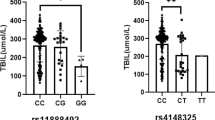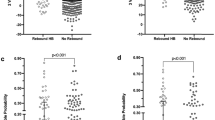Abstract
Background:
The aim of this study was to establish a model to identify term breast-fed infants who are at risk of developing significant neonatal hyperbilirubinemia.
Methods:
A prospective study was designed to investigate the effects of birth weight, mode of delivery, cephalohematoma, glucose-6-phosphate dehydrogenase (G6PD) deficiency, predischarge total serum bilirubin, variant uridine 5’diphospho-glucuronosyltransferase 1A1 (UGT1A1) gene, and hepatic solute carrier organic anion transporter 1B1 (SLCO1B1) gene on significant hyperbilirubinemia in term breast-fed neonates. Significant hyperbilirubinemia was defined as a bilirubin level exceeding the hour-specific phototherapy treatment threshold recommended by the American Academy of Pediatrics in 2004.
Results:
Of 240 exclusively breast-fed term neonates, 26 (10.8%) had significant hyperbilirubinemia. The predischarge total serum bilirubin on the third day (odds ratio (OR) = 2.63; 95% confidence interval (CI): 1.87–3.70; P < 0.001) and the variant UGT1A1 gene at nucleotide 211 (OR = 5.00; 95% CI: 1.08–23.03; P < 0.05) were significant risk factors. The area under the receiver operating characteristic (ROC) curve of the predictive probability was 0.964 (95% CI: 0.932–0.984; P < 0.0001).
Conclusion:
Combining the total serum bilirubin on the third day and the variant UGT1A1 gene at nucleotide 211 can predict hyperbilirubinemia well in term breast-fed infants.
Similar content being viewed by others
Log in or create a free account to read this content
Gain free access to this article, as well as selected content from this journal and more on nature.com
or
References
Gourley GR . Breast-feeding, neonatal jaundice and kernicterus. Semin Neonatol 2002;7:135–41.
Johnson L, Bhutani VK . Guidelines for management of the jaundiced term and near-term infant. Clin Perinatol 1998;25:555–74, viii.
Ives NK . Neonatal jaundice. In: Rennie JM, Roberton NRC, eds. Textbook of Neonatology. Edinburgh, UK: Churchill-Livingston, 1999:715–32.
Huang MJ, Kua KE, Teng HC, Tang KS, Weng HW, Huang CS . Risk factors for severe hyperbilirubinemia in neonates. Pediatr Res 2004;56:682–9.
Chang PF, Lin YC, Liu K, Yeh SJ, Ni YH . Prolonged unconjugated hyperbiliriubinemia in breast-fed male infants with a mutation of uridine diphosphate-glucuronosyl transferase. J Pediatr 2009;155:860–3.
Kaplan M, Herschel M, Hammerman C, Hoyer JD, Heller GZ, Stevenson DK . Neonatal hyperbilirubinemia in African American males: the importance of glucose-6-phosphate dehydrogenase deficiency. J Pediatr 2006;149:83–8.
Chang PF, Lin YC, Liu K, Yeh SJ, Ni YH . Risk of hyperbilirubinemia in breast-fed infants. J Pediatr 2011;159:561–5.
Linn S, Schoenbaum SC, Monson RR, Rosner B, Stubblefield PG, Ryan KJ . Epidemiology of neonatal hyperbilirubinemia. Pediatrics 1985;75:770–4.
Maisels MJ, Gifford K . Normal serum bilirubin levels in the newborn and the effect of breast-feeding. Pediatrics 1986;78:837–43.
Schneider AP 2nd . Breast milk jaundice in the newborn. A real entity. JAMA 1986;255:3270–4.
Hansen TW . Bilirubin production, breast-feeding and neonatal jaundice. Acta Paediatr 2001;90:716–7.
Keren R, Bhutani VK, Luan X, Nihtianova S, Cnaan A, Schwartz JS . Identifying newborns at risk of significant hyperbilirubinaemia: a comparison of two recommended approaches. Arch Dis Child 2005;90:415–21.
Newman TB, Liljestrand P, Escobar GJ . Combining clinical risk factors with serum bilirubin levels to predict hyperbilirubinemia in newborns. Arch Pediatr Adolesc Med 2005;159:113–9.
Keren R, Luan X, Friedman S, Saddlemire S, Cnaan A, Bhutani VK . A comparison of alternative risk-assessment strategies for predicting significant neonatal hyperbilirubinemia in term and near-term infants. Pediatrics 2008;121:e170–9.
Maisels MJ, Deridder JM, Kring EA, Balasubramaniam M . Routine transcutaneous bilirubin measurements combined with clinical risk factors improve the prediction of subsequent hyperbilirubinemia. J Perinatol 2009;29:612–7.
Bhutani VK, Johnson L, Sivieri EM . Predictive ability of a predischarge hour-specific serum bilirubin for subsequent significant hyperbilirubinemia in healthy term and near-term newborns. Pediatrics 1999;103:6–14.
Stevenson DK, Fanaroff AA, Maisels MJ, et al. Prediction of hyperbilirubinemia in near-term and term infants. Pediatrics 2001;108:31–9.
Kaplan M, Hammerman C, Feldman R, Brisk R . Predischarge bilirubin screening in glucose-6-phosphate dehydrogenase-deficient neonates. Pediatrics 2000;105(3 Pt 1):533–7.
Kaplan M, Renbaum P, Levy-Lahad E, Hammerman C, Lahad A, Beutler E . Gilbert syndrome and glucose-6-phosphate dehydrogenase deficiency: a dose-dependent genetic interaction crucial to neonatal hyperbilirubinemia. Proc Natl Acad Sci USA 1997;94:12128–32.
Bancroft JD, Kreamer B, Gourley GR . Gilbert syndrome accelerates development of neonatal jaundice. J Pediatr 1998;132:656–60.
Cappellini MD, Martinez di Montemuros F, Sampietro M, Tavazzi D, Fiorelli G . The interaction between Gilbert’s syndrome and G6PD deficiency influences bilirubin levels. Br J Haematol 1999;104:928–9.
Sun G, Wu M, Cao J, Du L . Cord blood bilirubin level in relation to bilirubin UDP-glucuronosyltransferase gene missense allele in Chinese neonates. Acta Paediatr 2007;96:1622–5.
Akaba K, Kimura T, Sasaki A, et al. Neonatal hyperbilirubinemia and a common mutation of the bilirubin uridine diphosphate-glucuronosyltransferase gene in Japanese. J Hum Genet 1999;44:22–5.
Chiang SH, Fan ML, Hsiao KJ . External quality assurance programme for newborn screening of glucose-6-phosphate dehydrogenase deficiency. Ann Acad Med Singap 2008;37:Suppl 12:84–4.
Huang CS, Chang PF, Huang MJ, Chen ES, Hung KL . Relationship between bilirubin UDP-glucuronosyltransferase 1A1 gene and neonatal hyperbilirubinemia. Pediatr Res 2002;52:601–5.
Huang CS, Chang PF, Huang MJ, Chen ES, Chen WC . Glucose-6-phosphate dehydrogenase deficiency, the UDP-glucuronosyl transferase 1A1 gene, and neonatal hyperbilirubinemia. Gastroenterology 2002;123:127–33.
American Academy of Pediatrics. Management of hyperbilirubinemia in the newborn infant 35 or more weeks of gestation. Pediatrics 2004;114:297–316.
Author information
Authors and Affiliations
Corresponding author
PowerPoint slides
Rights and permissions
About this article
Cite this article
Chang, PF., Lin, YC., Liu, K. et al. Identifying term breast-fed infants at risk of significant hyperbilirubinemia. Pediatr Res 74, 408–412 (2013). https://doi.org/10.1038/pr.2013.120
Received:
Accepted:
Published:
Issue date:
DOI: https://doi.org/10.1038/pr.2013.120
This article is cited by
-
Hyperthyroxinemia at birth: a cause of idiopathic neonatal hyperbilirubinemia?
World Journal of Pediatrics (2018)
-
Risk assessment of gene variants for neonatal hyperbilirubinemia in Taiwan
BMC Pediatrics (2016)
-
Inherited disorders of bilirubin clearance
Pediatric Research (2016)



